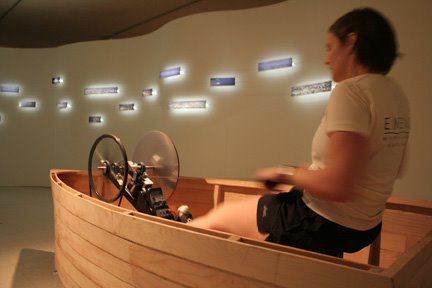
Via ecoartspace on facebook, I came across the Emergy project by Maria Michails (TreiaStudios). From the project website:
Emergy is an interactive installation art project bridging sculpture, performance, media arts, architecture, mechanical and electrical engineering. At the nucleus of the installation is a 9ft mechanized rowboat that will generate electricity to power lights in the gallery. The project investigates romantic attachments to traditional notions of technology, production and land use. The created environment examines energy and water consumption in an urban desert environment by contrasting human consumption with human expenditure. Raising awareness through embodied experience, the visitor will come to know what it takes to create energy that powers our world.
The concept of emergy is one that should be well considered in the designing of energy generating installation art in the landscape. In summary it is the energy used in the creation of an object and that is therefore “embodied” in that object. Everything has “emergy”. Natural biological objects have embodied energy from the sun stored in complex carbohydrates and other chemistries. Manufactured goods have that same natural embodied energy but in a more complicated cycle. The fossil fuels burned for the sake of production have their millions-of-years-old beginnings in that same sunlight. Even seemingly inert bedrock has embodied energy from the cosmological forces unleashed at the creation of the universe. This is most apparent in the core of the planet which burns as an ember from that alpha-energy still.
But what is most important to the sustainability of our planet is to understand non-renewable emergy. It is the manufactured objects of human creation that uniquely embody this type of energy. If we are to strike a balance in a post-fossil world we must learn how to pay back the debt of this non-renewable emergy on every object that we use in our daily lives.
The only way that an object manufactured by human hands and fossil-fueled electricity can ever pay back the debt of its embodied non-renewable energy is to utilize some part of itself to harness the renewable energy of the sun (either directly, or through wind and waves) and place back into the grid of production a clean energy for an extended duration until that new energy is equal in quantity to that which was used in its production. It must count all of the joules of energy embodied in all of the other non-renewable objects that were combusted or exhausted during the course of its production and the transportation of itself and of its byproducts and waste. If the object’s purpose is incompatible with this, then the object must ideally be infinitely reusable and/or recyclable so that its embodied energy can more easily be offset by renewable energy systems that have already paid off their own embodied energy debt. At some point, the object is also then “emergy debt free” and by continuing in its recycled life at that point lives on as an object with a zero-impact on the overall balance of the planet.

